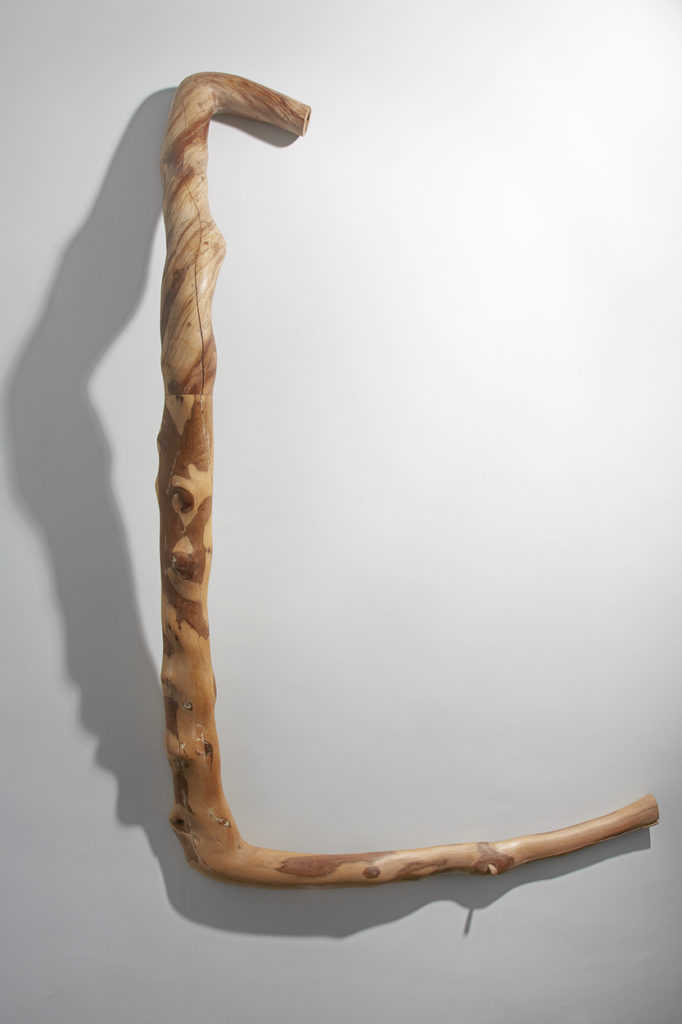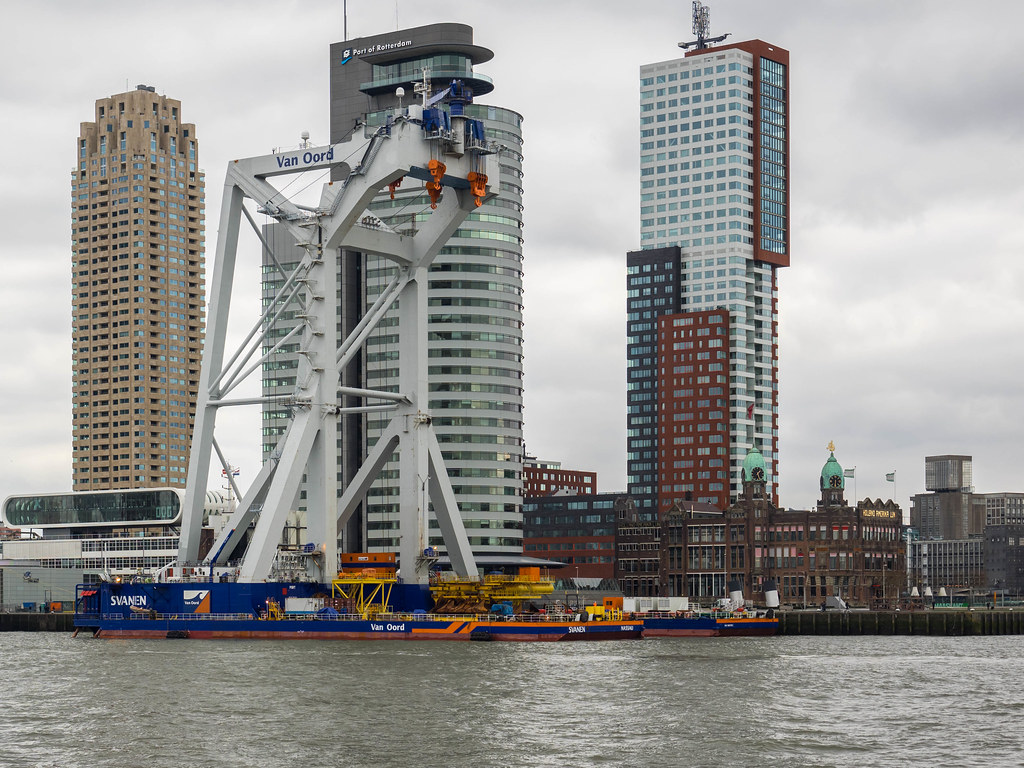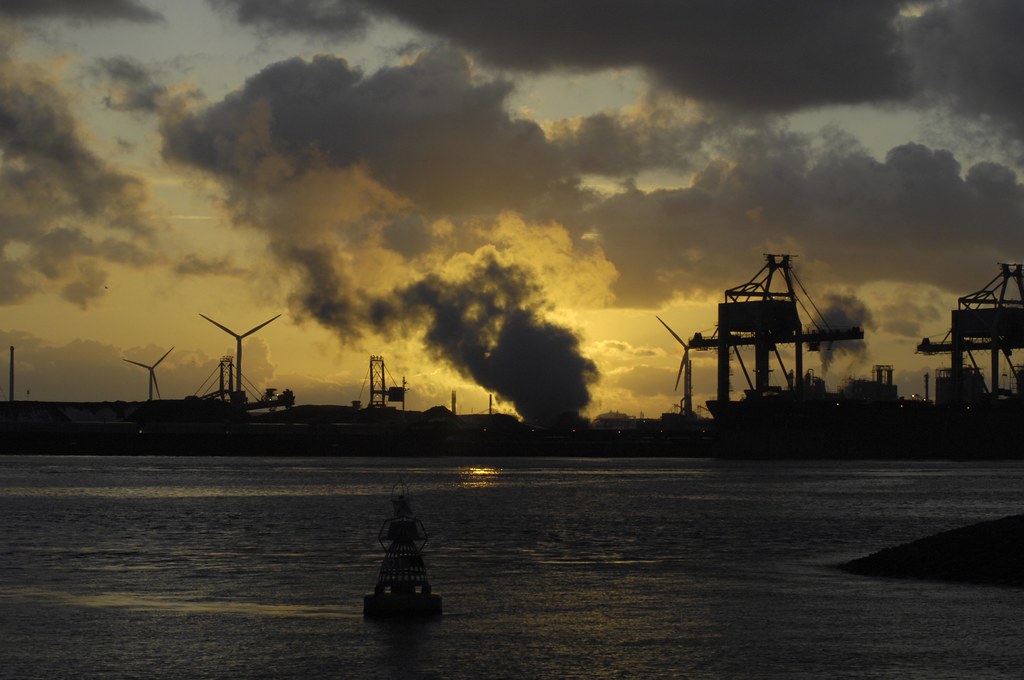
Doug Cocker’s Rotterdam belongs to a body of work that the artist created between 2004 and 2006. In 2004 he successfully applied for a major award from Creative Scotland, with a proposal to visit cities that he had never previously visited and which were linked by the North Sea, with the objective to create works inspired by the spirit of each place. Over the following months, Cocker travelled to Copenhagen, Hamburg and Rotterdam.
In Copenhagen, he was struck by the hand-wrought nature of the architecture and the extent to which the built environment is punctuated by numerous towers and spires.
In Hamburg, his attention was drawn to how the city’s footprint is determined by two sizeable bodies of water, the Aubenalster and the Binnenalster, which are connected by a narrow waterway.
In Rotterdam, meanwhile, it was the sheer magnitude of the port that inspired Cocker, extending as it does for forty-two kilometres inland. Perhaps unsurprisingly, he was drawn to the towering verticality and gigantism of the docks’ infrastructure.[i]
On his return to his studio in rural Angus, Cocker developed his impressions of these three port cities in drawings, etchings and small-scale models. Later, he embarked on a number of large-scale sculptures in timber. In each of these media, sinewy, hard-edged forms predominate, some loosely reminiscent of the angular shapes of buildings silhouetted against low, maritime horizons, others suggestive of the diagrammatic line of a watercourse as it might appear on a map.
Cocker, however, operates at a high level of abstraction, and the viewer who is intent on identifying detailed, recognisable motifs within these works is likely to be disappointed. It is considerably more helpful to regard these visits as his creative catalysts, stimulating him to introduce new themes and shapes into his already-rich, form-making repertoire.
Cocker is a sculptor who frequently seeks inspiration from specific topographies. In the years preceding his 2004 travels, he undertook similar trips to County Mayo in Ireland and to Malta, journeys which, in both instances, generated new bodies of work.
He also created multi-part relief works with titles such as Landsongs, Fast Horizons, and Travelled Landscapes, which writers justifiably associate with the undulating fields and farmlands of Tayside, where he was brought up, and where he has chosen to make his home.[ii]
The serial format of these abstract sculptures encourages viewers to notice small variations in the compositions, and to interpret their rhythmic modifications as reflective of the ever-changing play that weather, mood and point of view have on our impressions of a place.
There is, however, no poetics of locality of the kind that Cocker explores without an attendant investment in travel. Only by actually being in a topography and moving through it can anyone experience place as an enveloping presence, and only by passing onwards is it possible to become receptive to changes in the character and ambience of different surroundings.
While the works comprising Cocker’s ‘Nouns of Europe’ series are about places, they also invoke an associated interest in movement and connection. Rotterdam is no exception.
Rotterdam is currently installed in a stairwell in the School of Art History building on North Street, and is over two metres high, looming well above anyone who is passing from one storey to the next. As you ascend from the building’s ground level it looms suddenly into view, and feels disproportionately large, which is in keeping with Cocker’s intent on conveying the industrial gigantism that is to be seen in this major port.
It’s also worth remembering that Rotterdam’s docks are an international transportation hub, connected by water to hundreds of other harbours around the globe. And this linear work, which loosely resembles a giant L-shape, also strongly implies a sense of directionality, as if marking a definite course between points.
There is another dimension to Rotterdam, though, which is unmissable to anyone who pays the work even a passing glance. Rotterdam is constructed from tree boughs, and Cocker preserves in the finished piece the bulbous, undulating, curving surfaces of the stout branches from which it was sawn. The prominent lower, right-angle bend is, for instance, the crook of a limb.
But if you pay the work further attention you soon notice that Rotterdam is not exactly a found form, and that the timber has been substantially worked. The bark and pithy outer layers have been filed down and abraded before being sanded over, fissures have been filled with epoxy, a small wedge extends from a knothole plug in the lower, horizontal section. There are also visible saw lines running the length of the branches from top to bottom. If you stand at right angles, you also notice that a square channel appears to be gouged into the wood, implying that the branches are at least partially hollow.
I discussed the construction process with Cocker and was surprised to learn how elaborate the procedure had been.[iii] He told me that the timber derived from two sources. He had been approached by a farmer who owned a field near Coupar Angus which had a row of damson trees running along the banks of a burn on one side. In 2004, several had blown down in a gale, and were blocking the water’s passage. In exchange for clearing up the banks and restoring the stream’s path, the farmer invited Cocker to take the timber.
Damson wood is not commonly worked and is seldom commercially available. But it is prized by woodturners for its deep rich tones, which we see in the upper section of the work’s vertical element.
The lower segment of the sculpture, however, derives from an entirely different tree. It is formed from a mature yew branch, which was also locally sourced, although this time from trees that were felled on the Murthly Estate in Perthshire and were subsequently made available for Cocker to use.
Although the tonality of seasoned yew happens to be relatively similar to damson, it is a demanding and very different type of wood with which to work. Yew is identified by the dramatic colour differentiation between the light orangey sapwood and the dark heartwood and it is this that gives the lower lengths of Rotterdam its unusual pied tones and its distinctive protuberances.
Cocker identified a branch that also included a small perpendicular bend, and which matched the thickness of the damson, and carefully jointed the two limbs together securely. Once you know to look out for it, the juncture is clearly visible in the finished work, and the more you study the intersection, the more vivid the differences in the qualities of the species appear, with the damson’s dynamic, swirling grain contrastingly offset against the more placid yew.
To secure this joint mechanically, Cocker made some labour-intensive interventions into both branches of wood. He cut both the damson and the yew lengthwise, carefully feeding them through his bandsaw. Given their awkward dimensions, this can hardly have been a straightforward operation. Then he sliced a long central groove down their now-exposed inner, flat sides, extracting much of the heartwood, and enabling him to insert long, loose tenons into the cavity. Then he glued up and reassembled the branches into their current configuration, ensuring that a concealed length of timber linked both damson and yew.
These details about the source of Rotterdam’s materials, as well as Cocker’s account of the construction process, provide a somewhat different perspective on the sculpture. We see it now in terms of his sculptural practice, involving, as it does, his close engagement with workers on local farms and estates, and as the outcome of a sequence of time-consuming and technical workshop procedures.
As an artist, Cocker is widely admired for his skills in using wood (although he is careful to avoid the impression that his objective is to draw out the inherent beauty of his materials). Learning of the wood’s origins, and thinking of the sculptor in his Angus studio, confirms our impression that Rotterdam derives from the rural Scottish landscape in a tangible sense, and makes it a sculpture about a very different place to that which it is representing.
It is perhaps disjuncture – between geographies, between the wood as a material and the urban, industrial themes it is symbolizing, and between the two timbers themselves – that makes Rotterdam such a compelling and hybrid work.
Places, after all, are connected to one another. We pass between them, and we link them up in our lives in order to make sense of who we are. The damson and the yew grow apart, but here their branches have been cut and aligned, and Rotterdam is not Scotland, although the sea that fills its docks also washes against these shores.
[i] Doug Cocker, Artist’s statement, in ‘Nouns of Europe’, exhibition pamphlet, White Space, University of Abertay Dundee, 2008.
[ii] For a discussion of these works, see the essays by Robin H. Rodger and Finlay Coupar in Leaving Jericho: New Work in Response to Scottish Landscape & Language, Doug Cocker & Arthur Watson, exhibition catalogue, John David Mooney Foundation, Chicago 2013, pp. 37 and 39.
[iii] Doug Cocker, telephone conversation with the Author, 2 October 2020.
Author Details:
Alistair Rider is Senior Lecturer in the School of Art History. He writes about modern and contemporary sculpture, and about art making as a social practice. He is currently preparing a study on long-term artists’ projects since the 1960s.


